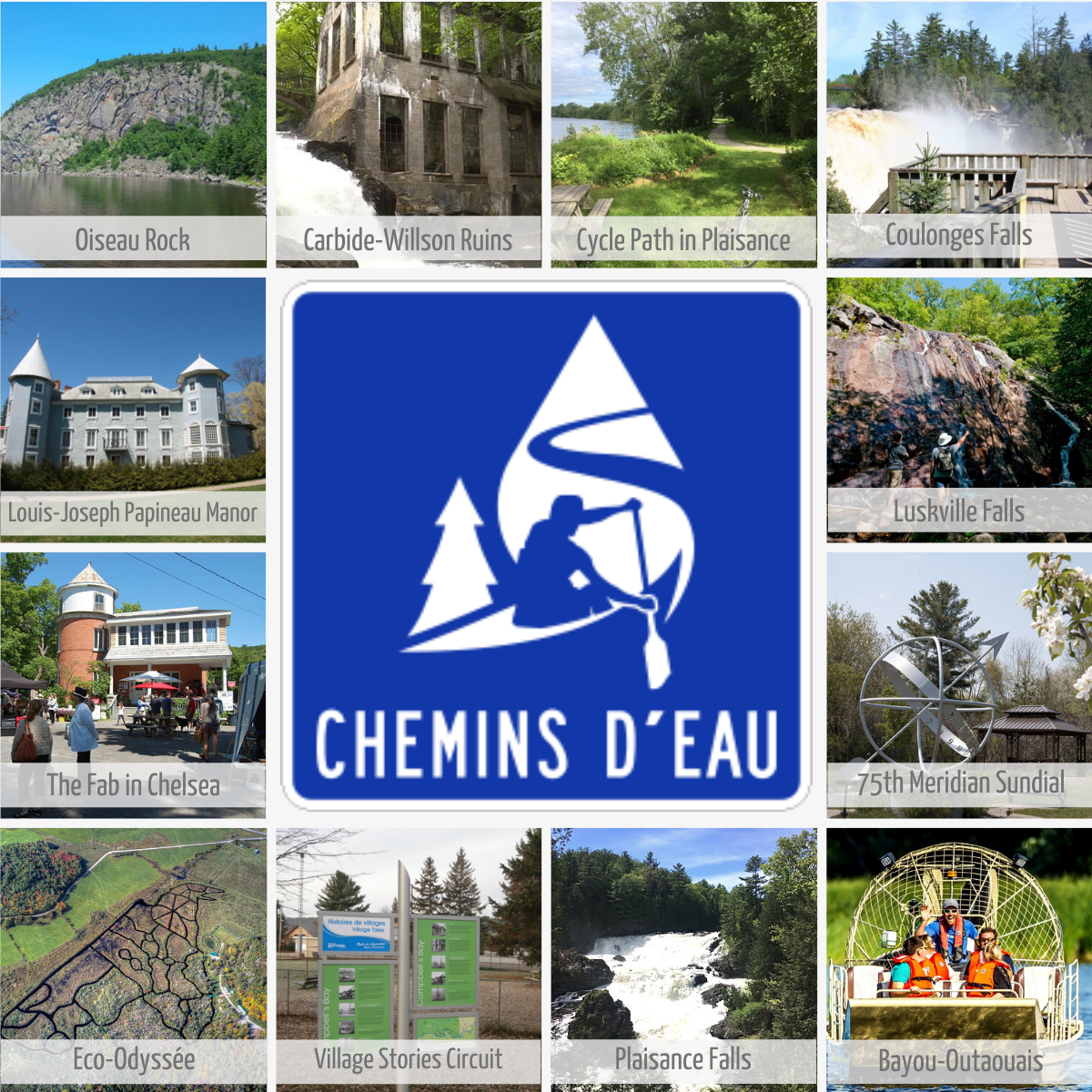
Accéder à la version française
Tom's Blogs > Category: Local Attractions > Chemins D'Eau, The Tourist Route in Outaouais
CHEMINS D'EAU, THE TOURIST ROUTE IN OUTAOUAIS
TO EACH REGION ITS OWN TOURIST ROUTE
In Quebec, each tourist region has its own thematic route or tourist circuit. In the Quebec City area, it is the Route de la Nouvelle-France. In Charlevoix, it is the Flavors, Mountains and River Routes. In the Eastern Townships, there are various wine routes, the Route des sommets and the Chemin des Cantons. In Montérégie, it's the Route du Richelieu and in the Laurentians, it is the Chemin du terroir and the Route des belles histoires, just to name a few, because there are many others. In short, to each his own historical, gourmet or panoramic route. In the Outaouais, we have the tourist route Les Chemins d'eau (Water Trails) and Auberge Tom B&B is part of it as a heritage accommodation.
This summer, I invite you to travel this route by car or bicycle to discover all that the Outaouais has to offer!
7 MILESTONES MARK THE ROUTE
Les Chemins d'eau is a 273 km historic circuit on the shores of the Ottawa and Gatineau rivers to discover the cultural and natural heritage of the greater Outaouais region. From east to west, from Fassett in Petite-Nation to Mansfield-et-Pontrefact in Pontiac, branching north through the Gatineau Hills, 7 markers have been placed along the route to invite travellers to stop at strategic points along the way.
- PAPINEAU - ON THE WAY OF THE LORDS: Montebello Tourist Information Office
- DU LIÈVRE RIVER - ENERGY DEVELOPMENT SOURCE: Buckingham Historical Society
- GATINEAU AND OTTAWA RIVERS - MILLENNIAL MERGER: Jacques-Cartier Street, Gatineau Sector
- LES COLLINES-DE-L'OUTAOUAIS (GATINEAU HILLS) - A CHARM THAT LASTS: Fairbairn House Heritage Centre, La Pêche
- DE LA BRASSERIE CREEK- BIRTHPLACE OF THE OUTAOUAIS: Beer Museum at Les Brasseurs du Temps, Hull Sector
- DESCHÊNES LAKE - IN THE HEART OF A HOLIDAY RESORT: Symmes Inn Museum, Aylmer Sector
- PONTIAC - ON THE TRAIL OF LOG DRIVERS: George Bryson Cultural House, Mansfield-et-Pontrefact
The route is marked by blue signs that direct travellers on the canoeists' tracks to more than 90 attractions in the region.
Follow the canoeist!

CIRCUIT OF THE OTTAWA RIVER, FROM FASSET TO MANSFIELD-AND-PONTREFACT
The Ottawa River, the longest river in Quebec, has played a decisive role in the history of Quebec and more particularly in the history of our region. It originates in Lake Outaouais and ends its course in the St. Lawrence River, after the Lake of Two Mountains west of Montreal, 1,271 km away. In the Outaouais, it has five affluents, the Gatineau, Blanche, du Lièvre, Petite Nation and Rouge rivers. It forms a natural border for several kilometers with the province of Ontario and separates the cities of Ottawa and Gatineau.
From Fasset, Route 148 follows the Ottawa River to Mansfield-et-Pontrefact. The river is clearly visible along scenic Highway 148. It is possible to take highway 50 between Fassett and Gatineau. The highway offers, in some places, magnificent views of the river from high up and a few lookouts have been built for this purpose.
Here are some of the main attractions along the Ottawa River from Fasset to Mansfield-et-Pontrefact that are part of the Chemins d'eau route:
- Fromagerie Montebello (Cheese Factory)
- Montebello Heritage Tour
- Manoir Papineau National Historic Site
- Oméga Park
- Musée des pionniers (Pioneers Museum)
- Louis-Joseph Papineau Tour
- 75th Meridian Sundial
- Plaisance Heritage Interpretation Centre
- Plaisance Falls
- Plaisance National Park
- Cycle Path from Plaisance to Thurso
- Walking Tour Masson, The Hub Of The Wood Sector
- Walking Tour Buckingham, A City Of Energy
- The Buckingham Historical Society
- Beauchamp Lake Park
- Bayou-Outaouais - Airboat Tours
- Walking Tour Gatineau Mills, An Industrial Town
- Heritage Walking Tour of Aylmer's Old Village
- Symmes Inn Museum
- Exhibition Centre L'Imagier
- Luskville Falls
- Norway Bay Beach
- The Shawville Historical Walking Tour
- PPJ Cyclopark
- L'Île-du-Grand-Calumet
- Pontiac Heritage Road Trip
- Coulonges Falls Park
- George Bryson Cultural House and Félix-Gabriel-Marchand Covered Bridge
- L'Isle-aux-Allumettes
- Oiseau Rock Trail

GATINEAU RIVER CIRCUIT - CANTLEY, WAKEFIELD, LA PÊCHE AND CHELSEA
The 443 km long Gatineau River originates at Sugar Loaf Lake, flows through the Baskatong Reservoir and ends in the Ottawa River. It is the second largest river in the Outaouais, but few people really know it because it is mostly bordered by private properties. In Outaouais, the Gatineau River acts as a natural division between the municipalities of Cantley on the east shore and Chelsea and La Pêche on the west shore.
It is easy to drive along the Gatineau River on both banks, thanks to routes 307 (Cantley) and 105 (Chelsea/La Pêche). This circuit of the Chemins D'Eau route forms a loop. From Route 148, in the Gatineau sector, first take Route 307 to Wakefield, cross the river and then go south on Route 105 through Chelsea. You will then reach Highway 148, where you can continue along the Ottawa River, either via Laurier Boulevard or Des Allumettières Boulevard.
Here are the main attractions of the Gatineau River Loop:
- Rapides-Farmer Generating Station
- Éco-Odyssée
- Fairbairn House Heritage & Wakefield Covered Bridge
- Carbide Willson Ruins
- Hills and Water Trail
- Mackenzie-King Estate
- The Fab - Chelsea Arts, Culture and Heritage Centre
- Walking Tour From Hautes-Plaines To Vieux-Port

KIRK'S FERRY
Auberge Tom B&B is part of this loop on the Gatineau River. The original property, a small 3-bedroom wooden house, was built in 1934 on land used for raspberry growing. The fertile soil was lush for this type of crop and many houses boasted of making delicious jams from the berries grown in their own backyards.
The Gatineau River in our area of Kirk's Ferry was much narrower in the 1930s. A few years later, Hydro-Québec flooded farms along the river to produce hydroelectric power at the Chelsea dams, and allowed lumber from the Mont-Laurier area to float to the paper mills in Hull.
The Kirk's Ferry service in Cantley established by Thomas Kirk operated regularly on the Gatineau River. Following the flooding of farmland by Hydro-Québec, parcels of land were surveyed along the river and offered for sale to the owners of the flooded areas.
In 1987 and 1988, logging on the Gatineau River was halted and residences along the river began to clean up the shoreline of stranded logs. Canoeists, boaters and swimmers could now enjoy the river without fear of running into floating logs.
Long used for the transportation of materials and merchandise, the railroad linked Hull to Maniwaki and then to the Laurentians via the northern railroad network. In 1992, the Steam Engine tourist steam train linking Hull to Wakefield, which passed within walking distance of the property, began operations under the name of the Choo-Choo Train Company and was later renamed the Hull-Chelsea-Wakefield Steam Train. The train ceased operations in 2011 due to landslides, and the railway was dismantled a few years ago, giving way to a nice trail about 20 km long located just below our property.

DOWNTOWN CIRCUIT - DE LA BRASSERIE CREEK AND LEAMY LAKE
Downtown Gatineau, formerly the City of Hull, is located at the confluence of the two rivers. De la Brasserie Creek crosses this area and connects the two rivers. Here are the main attractions of the Chemins D'Eau route located in the downtown area:
- Des Portageurs Park
- The Moore Farm Estate
- The Beer Museum of Les Brasseurs du Temps
- Walking Tour Chemin de la Mine
- Canadian Museum of History and Jacques-Cartier Park
- Aubry Place
- Montcalm Gallery
- The Authors Pavilion (Charron House)
- Des Voyageurs Pathway
- Aqua-Taxis Au feel de l'eau
- Lady Drive Tours
- Capital Cruises
- Lake Leamy Park
- Rabaska Canada
- Captain Paul Cruises

RESTAURANTS ON THE CIRCUIT
The Outaouais region counts more than a hundred restaurants for all tastes and budgets, including some award-winning restaurants. Of this regular offer, about ten restaurants are part of the Chemins D'Eau route. Here they are according to the sectors:
Montebello
- Délice Champêtre
- Bistro Montebello
Downtown Gatineau, Hull Sector
- Soif, wine bar
- Les Brasseurs du Temps
- Les Vilains Garçons
Chelsea
- Biscotti & cie
- Chelsea Pub
- L'Orée du bois
Gatineau, Aylmer Sector
- L'Aubergiste
Shawville
- Café 349
Fort Coulonge
- Bistro du bûcheron de Bryson
All content © Auberge Tom B&B 2022.
All rights reserved.


